




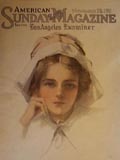
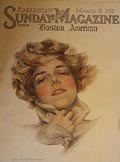
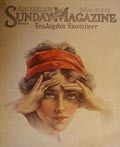
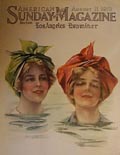
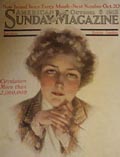

|
Boileau in the American Sunday Monthly Magazine, by Norm Platnick
Note: This article is updated from the original version, which appeared in the July, 1998 issue of The Philip Boileau Collectors' Society Newsletter. See our Links page for information on the society and its publications.
Collecting magazine covers by Philip Boileau can be a challenging hobby! In some cases (such as the Saturday Evening Post), we know exactly how many paintings Boileau supplied for a given magazine, and when they appeared, and the challenge is simply to try to find them all (I know of only two collectors fortunate enough to have found all 34 Boileau Post covers!). In other cases, our knowledge is far more fragmentary, and probably there is no area so confused as the Boileau "Sunday Magazines."
During the period of Boileau's activity as a cover artist, there seem to have been four different national syndicates of newspapers that produced Sunday magazine sections with covers by famous illustrators. These different magazines are frequently confused with each other, making it extremely difficult to identify images and match them with titles and citations (such as those in Dorothy Ryan's 1981 book, "Philip Boileau: Painter of Fair Women"). The different syndicates probably arose as a simple matter of economics. In large cities with more than one major newspaper, each paper had to have its own Sunday supplement, different from those distributed by its competitors. Single newspapers generally couldn't afford to commission nationally known artists to paint covers just for them, and the syndicates enabled groups of papers in different cities to spread those high costs across several enterprises.
As a result, the "Sunday Magazines" of this era actually represent at least four different periodicals most easily referred to as:
1) the American Sunday Monthly Magazine,
2) the Associated Sunday Magazine (the "Associated" name appears only in a line of tiny gray print on the cover, usually near the masthead, reading "Copyright, 19xx, by Associated Sunday Magazines, Incorporated"),
3) the Illustrated Sunday Magazine, and
4) the National Sunday Magazine.
Their exact titles varied a bit over time and space, but these four syndicates together seem to account for about 99% of the Sunday Magazine supplements of this era. In Beantown, for example, the Boston American ran the American Sunday Monthly Magazine, the Boston Post ran the Associated Sunday Magazine, the Boston Herald ran the Illustrated Sunday Magazine, and the Boston Globe ran the National Sunday Magazine.
The Boileau covers known to have appeared in the American Sunday Monthly Magazine are shown here. I've not been fortunate enough to work through a set of bound volumes of this periodical for the appropriate years, so it is possible that the information provided here is still quite incomplete!
The American Sunday Monthly ran illustrated covers from at least late 1911 through mid-1916. For at least a short period, between Nov. 1912 and Jan. 1913, it was produced twice, rather than just once, a month, and was then called the American Sunday Twice A Month Magazine (or Magazine Section). Over its full life span, images by Penrhyn Stanlaws, Rolf Armstrong, and Harrison Fisher, as well as Boileau, were featured on its covers. The magazine appeared in at least six newspapers: Hearst's Sunday American of Atlanta, the Boston American, the Chicago Examiner, the Los Angeles Examiner, the New York American, and the San Francisco Examiner. Early issues show no publisher on the cover, but from at least Feb. 4, 1912 through Sept. 8, 1912 the publisher was the American-Journal-Examiner Co.; later issues were published by the Star Co. instead. The earlier publisher name suggests that the magazine appeared in at least one more newspaper (with "Journal" in its title).
The American Sunday Monthly differed from its competitors in not appearing weekly, and (perhaps as a result of that more relaxed schedule), it presents an odd wrinkle: the same image can be found on magazines with different dates! So far as I've been able to determine (from studying Armstrong, Boileau, Fisher, and Stanlaws covers), the differences simply reflect geography. A given image would appear on the same date in Boston, New York, and Chicago. However, the two California newspapers would run that same image a week later, perhaps allowing more time for the transport of printing plates or finished magazines across the continent.
In any case, there are currently six known Boileau covers for the American Sunday Monthly. The first, called "Girl's Head" (as well as "A Hundred Years Ago" and "Puritan Maid") in Ryan's book, is known from Nov. 5 and 12, 1911 (New York/Chicago and Los Angeles, respectively).
The second image, "Old Home, Farewell!", is known so far only for Mar. 3, 1912 (Boston) but presumably also appeared on Mar. 10, 1912 in Los Angeles and San Francisco. It closely resembles another image used several years later as a cover for McCall's (Jan. 1917), called "Chic." Interestingly, "Chic" also appeared on the St. Louis Post-Dispatch Sunday Magazine for Feb. 11, 1917, where it was described as "Philip Boileau's Last Picture." The St. Louis Post-Dispatch Sunday Magazine seems to be one of the few Sunday supplements that was not part of a syndicate.
The third image is untitled: it is a girl's head with both hands shading her eyes. This cover appeared in the Los Angeles Examiner on May 12, 1912, and in at least one of the eastern papers a week earlier, on May 5, 1912.
The fourth image, also untitled, shows two swimmer's heads, each wrapped in a colorful scarf. This cover appeared in the Boston American on Aug. 4, 1912, and in the Los Angeles Examiner on Aug. 11, 1912.
The fifth image is listed in Ryan's book as U20 (i.e., untitled image #20), and is known from the Boston American for Oct. 6, 1912.
Finally, the sixth image, "My Boy," appeared in the Chicago Examiner on Jan. 19, 1913.?

|